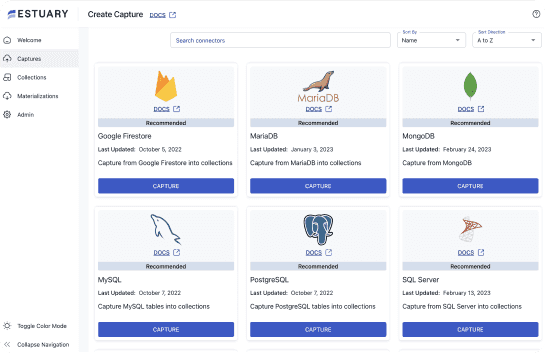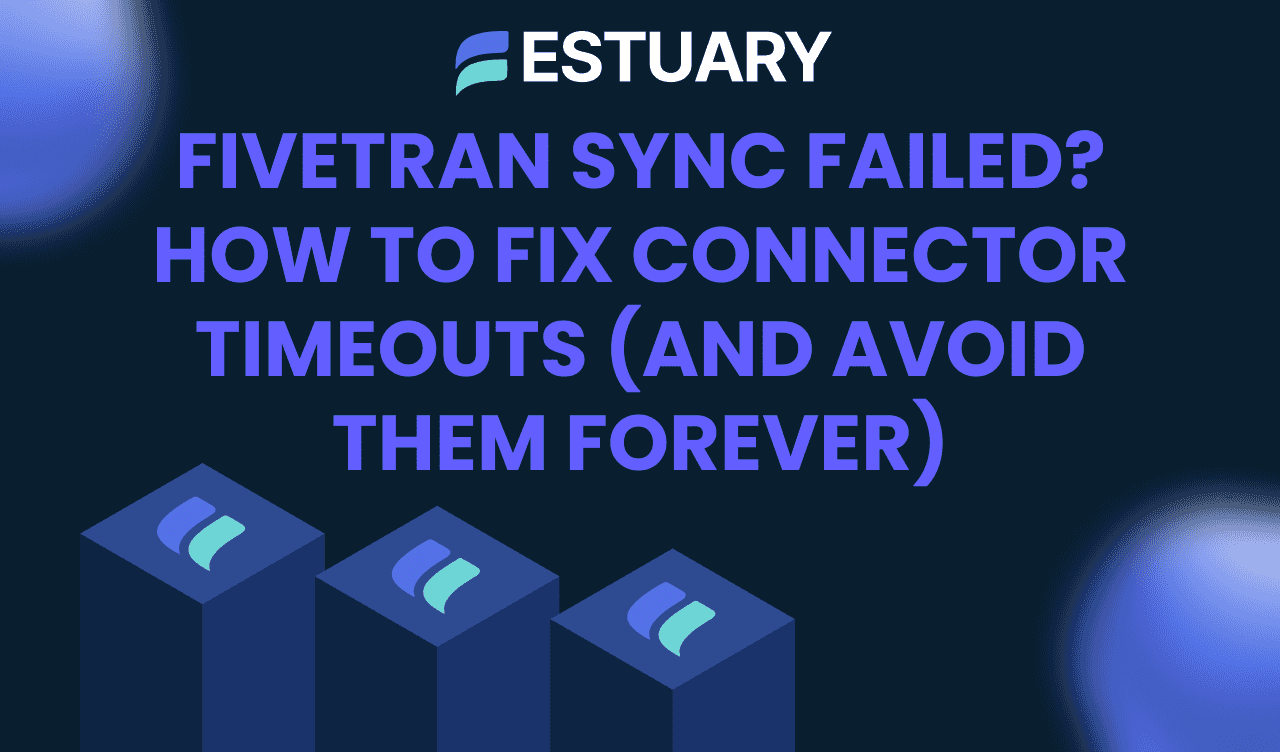
Few things frustrate data engineers as much as seeing their sync jobs repeatedly fail due to connector timeouts. If you’re using Fivetran, you've likely encountered this dreaded situation at least once: a critical sync pipeline stalls or crashes because a connector timed out, leaving you scrambling to troubleshoot the issue and manually restart jobs.
This guide'll explore why Fivetran sync jobs fail with timeout errors, provide actionable fixes you can implement immediately, and introduce how Estuary Flow’s streaming model eliminates batch timeout risks.
Quick Summary (TL;DR)
Fivetran sync timeouts commonly occur due to the following:
- Long-running batch processes
- Source systems throttling API or database connections
- Large incremental syncs overwhelm connector resources
Immediate fixes include:
- Splitting large sync jobs into smaller batches
- Increasing timeout settings in Fivetran (where available)
- Scheduling syncs during off-peak hours
However, the permanent solution is shifting from batch to streaming:
- Estuary Flow uses continuous streaming, eliminating batch timeouts.
- Real-time, incremental updates without heavy resource spikes.
Let's break this down further.
Why Do Fivetran Connector Timeouts Occur?
If you're wondering why your Fivetran sync failed with a timeout error, the root causes usually fall into three categories:
Problem 1: Large Batch Processes
Fivetran’s batch-driven architecture fetches data in chunks at scheduled intervals. This batch approach can take too long for large datasets or slow source systems, causing Fivetran to terminate the sync due to pre-set timeout limits. This frequently results in incomplete data updates and frustrating manual restarts.
Problem 2: Throttling by Source Systems
API-based connectors frequently encounter throttling from the source API. Popular sources like Salesforce, HubSpot, or Google APIs impose strict request rate limits. When Fivetran exceeds these limits, the connectors stall or time out, stopping data flows and leaving engineers with stale data.
Problem 3: Resource Overload on Incremental Syncs
When incremental updates involve millions of rows, connectors might struggle to process this data efficiently in batch mode. Large incremental data transfers overwhelm connector resources, eventually causing the sync to timeout.
How Connector Timeouts Impact Your Data Operations
Connector timeouts are not just technical nuisances. They have real-world consequences:
- Data freshness suffers, compromising the reliability of analytics and reporting.
- Engineering teams waste hours troubleshooting and manually restarting pipelines.
- Frequent timeouts undermine confidence in your data stack’s stability.
How to Fix Fivetran Connector Timeout Errors Immediately
If you're facing urgent timeout issues, try these immediate fixes:
Fix 1: Reduce Sync Job Size
Split large batch syncs into smaller, more manageable batches. Smaller batches can be completed faster, reducing timeout likelihood.
Action Steps:
- Segment your tables or data sources into multiple sync jobs.
- Schedule staggered sync intervals.
Fix 2: Adjust Timeout Settings
Fivetran allows customization of timeout settings for specific connectors. Increasing this threshold can temporarily mitigate the timeout issue.
Action Steps:
- Adjust connector settings to extend timeout limits.
- Monitor closely to ensure increased timeouts do not negatively impact source systems.
Fix 3: Optimize Sync Scheduling
Schedule large sync jobs during off-peak hours to avoid API rate limits and system resource constraints.
Action Steps:
- Identify low-traffic periods (e.g., late-night hours).
- Adjust your Fivetran sync schedules accordingly.
The Real, Long-term Fix: Streaming Instead of Batch
While immediate solutions can temporarily mitigate issues, the fundamental problem—batch architecture—remains. The best permanent fix is eliminating batch processes.
Estuary Flow leverages streaming and real-time data ingestion, completely removing timeout risks associated with batch jobs.
How Estuary Flow Prevents Timeouts
Continuous Streaming = No Timeouts
Unlike Fivetran’s batch model, Estuary Flow ingests data continuously, meaning:
- Data moves as soon as it’s available, removing large batch loads.
- API throttling is easily handled through built-in backpressure and controlled ingestion rates.
- Incremental syncs are instantaneous and lightweight, preventing resource overload.
Real-Time Incremental Updates
Flow performs incremental updates in real time, eliminating large incremental transfers. This significantly reduces the source systems and connectors load, preventing resource exhaustion and subsequent timeout errors.
Example: Salesforce Data with Fivetran vs. Estuary Flow
Consider syncing Salesforce data:
- Fivetran: Large batches fetching data hourly may timeout frequently due to Salesforce API throttling or large data volume.
- Estuary Flow: Continuous incremental ingestion from Salesforce APIs eliminates extensive batch processing, preventing timeouts and maintaining consistent, real-time updates.
Why Choose Estuary Flow Over Fivetran for Timeout-Free Syncs?
Here’s a quick comparison:
Feature | Fivetran | Estuary Flow |
| Data Ingestion Model | Batch | Real-time Streaming |
| Timeout Risks | Frequent | None |
| Incremental Sync Performance | Heavy resource use, often slow | Lightweight, instant |
| API Throttling | Causes frequent sync failures | Managed through backpressure |
| Operational Overhead | Manual restarts common | Fully automatic retries |
Real-World Benefits of Estuary Flow
An Estuary customer previously struggling with Fivetran batch sync timeouts saw immediate improvements after migrating to Flow:
- Zero timeouts: Continuous ingestion removed timeout issues completely.
- Reduced latency: Real-time data availability greatly enhanced analytics accuracy and decision-making speed.
- Lower operational costs: Dramatically reduced manual interventions and troubleshooting overhead.
Transitioning from Fivetran to Estuary Flow
Migrating to Estuary Flow is straightforward:
- Quickly map your existing connectors to Flow’s managed real-time connectors.
- Configure your pipelines easily with Flow’s intuitive declarative interface.
- Validate your pipelines automatically with built-in schema checks and monitoring.
Within days, you'll experience improved reliability and operational simplicity.
Thinking about switching? Check out our full comparison: Estuary vs Fivetran
Key Takeaways
Connector timeouts in Fivetran pipelines severely affect operational efficiency, data reliability, and engineering productivity. While temporary fixes may mitigate immediate symptoms, transitioning from batch ingestion to continuous streaming is the only lasting solution.
Estuary Flow:
- Eliminates timeout risks.
- Provides continuous real-time ingestion.
- Reduces operational overhead significantly.
Final Thoughts
Connector timeouts shouldn’t be a routine part of your data engineering workflow. By switching to Estuary Flow’s streaming model, you’ll avoid timeout headaches forever, gaining stability, efficiency, and trust in your data operations.
Ready to permanently eliminate timeout risks? Get started with Estuary Flow today and streamline your data pipeline operations.

About the author
With over 15 years in data engineering, a seasoned expert in driving growth for early-stage data companies, focusing on strategies that attract customers and users. Extensive writing provides insights to help companies scale efficiently and effectively in an evolving data landscape.










